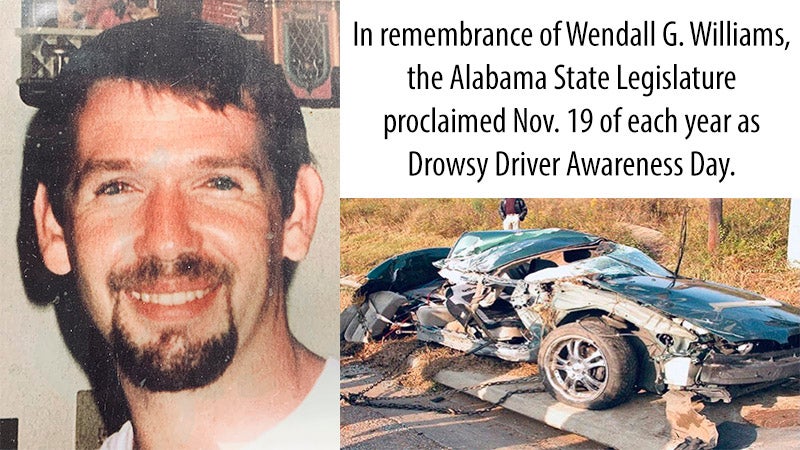After loss, local family helps bring awareness of drowsing driving
Published 4:00 pm Tuesday, November 19, 2024
|
Getting your Trinity Audio player ready...
|
Nov. 19, 2006 is a day that will forever be etched in the mind of Shelia Faulkner, who lost her son, Wendall G. Williams, in a tragic accident.
At the time, Williams was only 28 years old when he was killed in a horrific car crash as a passenger on an early Sunday morning. According to police reports, the driver of a green 2001 Nissan Altima was sober but evidently had gone without sleep between 22 and 30 hours. The driver fell asleep at the wheel as the vehicle ran into a pole at a local railroad crossing. It has now been 18 years since the incident occurred, and the driver has yet to receive a single citation for the actions.
“Wendall was the sweetest, kindest person you’d ever want to meet. He had a big heart and would do anything for anybody. He was very humble,” Faulkner said.
Faulkner reached out to the Alabama State Legislature, who first proclaimed Nov. 19 as Drowsy Driver Awareness Day. This year will mark eight years since that proclamation was passed in 2016. A segment about drowsing driver has since been added to the State of Alabama’s Driver’s Manual:
“Stop driving when you feel drowsy. Don’t try to fight it. Pull off the highway at the first rest stop or service area. If you are getting tired, a cup of coffee and a bit of stretching may be enough to wake you. If you are really sleepy, get off the highway and take a nap. Drowsiness is one of the greatest dangers in interstate highway driving. Don’t rely on ‘stay-awake drugs.’ They are likely to make your driving even more hazardous.
“It is advisable to take regular breaks every 100 miles or every two hours. Get out of the car and walk around stretch your legs and relax.
“For long trips, it is a good idea to take a pre-trip nap. On the road, exercise your eyes. Expressway drivers are subject to “highway hypnosis”- a condition of drowsiness or unawareness brought on by monotony: the sound of the wind, the tires on the pavement, and the steady hum of the engine. Shift your eyes from one area of roadway to another and focus them on various objects near and far, left and right. Reading highway signs also may keep you alert.”
According to the proclamation, the National Highway Traffic Safety Administration estimates that 100,000 police-reported vehicle crashes occur per year resulting in approximately 1,550 fatalities and 71,000 injuries. Most are attributed to the cost of driver fatigue.
A poll by the National Sleep Foundation found that 60 percent of all adults surveyed admitted driving a motor vehicle while drowsy. 37 percent of the same adults reported falling asleep at the wheel while driving. Between 2013 and 2017, more than 4,000 people were killed in car crashes in which drivers fell asleep or were too sleepy to safely operate a vehicle.
“I want to make the public aware of this situation because it is a very serious thing. There are now road signs on interstates and near rest stops instructing citizens to pull over if they feel drowsy,” Faulkner said. “My son was a victim of something that was beyond his control.”
The proclamation also stated that Alabama has no roadside test for a person to complete or for law enforcement to administer to determine whether a driver is too tired to drive. It goes on to read that many crashes attributed to alcohol or other causes may actually be the result of a sleepy driver.
Nov. 19 was designated as Drowsy Driver Awareness Day in Alabama as a continuing memorial to the many other loved ones who have suffered the same fate.
The proclamation adds that it also serves as an annual reminder of the tragic consequences of fatigued driving. It closes with a statement saying, “In observance of the day, the public shall be educated on the danger of driving drowsy and the many ways of preventing vehicular crashes related to drowsy driving in the future shall be emphasized.”






